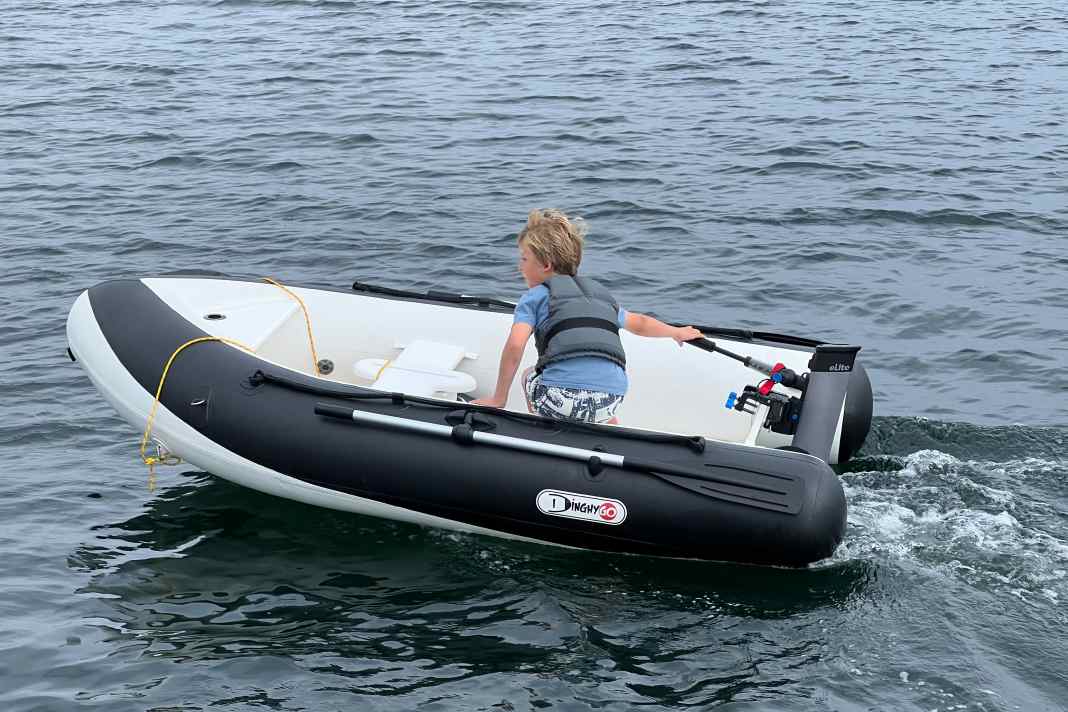





If you are looking for a drive for your dinghy, electric outboards are a must, at least if high speed is not required. However, the well-known models from Torqeedo or Epropulsion are relatively expensive and, with an input power of 1000 watts, already offer more thrust than is actually necessary for a dinghy. The Elite from Epropulsion is specially designed for use on dinghies and other small boats and, with its 500 watts of input power, is one of the most compact electric outboards with an integrated battery.
Assembly and handling
The low weight of 7.7 kilograms is an immediate plus point. The Elite can easily be carried into the dinghy with one hand. It is even more convenient if the removable bracket is already attached to the transom, because then the motor weighs just 6.5 kilograms and can be attached quickly. An additional bracket for the pushpit or storage space is available for 140 euros, which makes handling even easier.
It is attached to the transom with two wing screws, as is usual with outboard motors. The angle of the motor can be adjusted using a trim pin. For travelling in shallow water, the Elite can be unlocked so that it folds up automatically on contact. However, reverse gear should be avoided in this position as the screw will otherwise lift the motor out of the water. The Elite also has a shallow water position that locks the motor at a 36-degree angle and enables both forwards and reverse travel.
The propeller on our 3.20 metre long Dinghy Go drew air relatively easily in shallow water, which could be remedied by balancing the dinghy stern-first.
Driving performance and range
The charge status and engine power can be read on the display on the top of the engine. Even at half power, our dinghy with one adult and two children reached 2.7 knots. With a running time of 1.5 hours, this results in a range of around four nautical miles. At full power, the dinghy accelerated to 3.5 knots, which corresponds to the hull speed. The battery life was reduced to 40 minutes, which corresponds to a range of 2.3 nautical miles.
A special feature of the Elite is the sport mode. By pressing the power button twice, the motor power can be temporarily increased to 750 watts. This is an enormous increase in power, but it also comes at the expense of range and is therefore only available as long as the battery is at least half charged. The electronics then regulate the power down to the rated power. If the charge drops below ten per cent, only 340 watts are available, but this is perfectly sufficient for normal riding.
In practice, this means that even longer exploratory trips are no problem. However, if the youngsters frequently use the boat in the anchor bay, you should plan charging breaks. With the standard 230-volt charger, the energy storage unit can be fully recharged in around four hours.
Charging with solar power
The solar charging system is very practical for on-board use. It consists of a foldable 100-watt panel (330 euros) and a waterproof charge controller (110 euros). The clever thing is that the charge controller can also be supplied with 12 volts and can charge the Elite from the on-board power supply when the sun is not shining.
During our four-week summer cruise in the Swedish archipelago, we charged the engine exclusively using the solar panel, which worked very well. For extended shore excursions, it is a good idea to take the compact panel with you and simply place it on the dinghy on the beach. This means that the battery is fully charged again after going ashore and can be used for further exploratory trips.
Additional power bank function
A USB-C socket is concealed under a waterproof rubber cap. When the motor is switched on, the battery can be used as a power bank. The system supports Power Delivery and the QC3+ standard with a maximum output of 22 watts - sufficient for smartphones and similar devices.
The motor and accessories make a robust impression. Most components such as the brushless motor, the propeller, the electronics, the bracket or the folding tiller can be easily replaced if necessary. Only the waterproof moulded battery in the shaft cannot be replaced. As the energy storage unit is by far the most expensive component, replacing it would not make economic sense according to the manufacturer.
Price comparison and classification
At 1,100 euros, the Elite is well below the price of more powerful electric outboards:
| Engine | Performance | Battery capacity | Weight | Price |
| Torqeedo Travel 903 | 900 W | 915 Wh | 17.3 kg | 2,200 Euro |
| ePropulsion Spirit 1.0 | 1000 W | 1,276 Wh | 19.2 kg | 2,200 Euro |
| Temo 450 | 450 W | 290 Wh | 4.9 kg | 1,580 Euro |
| ePropulsion Elite | 500 W | 378 Wh | 7.7 kg | 1,100 Euro |
Even with the solar system (440 euros), the E-Lite remains cheaper than the more powerful alternatives at a total of 1,540 euros. At the same time, it is significantly lighter than the larger models and offers more power than the even lighter Temo 450.
We really liked the Epropulsion Elite as a drive for the dinghy. The design is elegant and well thought-out, and the performance is completely adequate. The somewhat limited battery capacity does not play a major role in practice, and it is offset by the low motor weight and the comparatively favourable price. The combination with the solar charging system is highly recommended.

